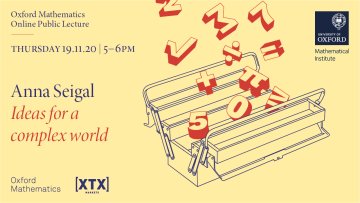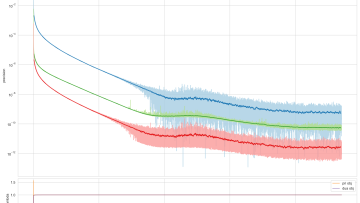Fernando Alday has been appointed Rouse Ball Professor of Mathematics in the University of Oxford. The Rouse Ball Professorship of Mathematics is one of the senior chairs in the Mathematics Department in Oxford (and also in Cambridge). The two positions were founded in 1927 by a bequest from the mathematician W. W. Rouse Ball.
Machine Learning for Mean Field Games
Abstract
Mean field games (MFG) and mean field control problems (MFC) are frameworks to study Nash equilibria or social optima in games with a continuum of agents. These problems can be used to approximate competitive or cooperative situations with a large finite number of agents. They have found a broad range of applications, from economics to crowd motion, energy production and risk management. Scalable numerical methods are a key step towards concrete applications. In this talk, we propose several numerical methods for MFG and MFC. These methods are based on machine learning tools such as function approximation via neural networks and stochastic optimization. We provide numerical results and we investigate the numerical analysis of these methods by proving bounds on the approximation scheme. If time permits, we will also discuss model-free methods based on extensions of the traditional reinforcement learning setting to the mean-field regime.
Open markets
Abstract
An open market is a subset of a larger equity market, composed of a certain fixed number of top‐capitalization stocks. Though the number of stocks in the open market is fixed, their composition changes over time, as each company's rank by market capitalization fluctuates. When one is allowed to invest also in a money market, an open market resembles the entire “closed” equity market in the sense that the market viability (lack of arbitrage) is equivalent to the existence of a numéraire portfolio (which cannot be outperformed). When access to the money market is prohibited, the class of portfolios shrinks significantly in open markets; in such a setting, we discuss how to construct functionally generated stock portfolios and the concept of the universal portfolio.
This talk is based on joint work with Ioannis Karatzas.
-------------------------------------------------------------------------------------------------
"Efficient approximation of high-dimensional functions with neural networks”
Abstract
We develop a framework for showing that neural networks can overcome the curse of dimensionality in different high-dimensional approximation problems. Our approach is based on the notion of a catalog network, which is a generalization of a standard neural network in which the nonlinear activation functions can vary from layer to layer as long as they are chosen from a predefined catalog of functions. As such, catalog networks constitute a rich family of continuous functions. We show that under appropriate conditions on the catalog, catalog networks can efficiently be approximated with ReLU-type networks and provide precise estimates on the number of parameters needed for a given approximation accuracy. As special cases of the general results, we obtain different classes of functions that can be approximated with ReLU networks without the curse of dimensionality.
A preprint is here: https://arxiv.org/abs/1912.04310
OCIAM DPhils present their research
Abstract
Amy Kent
Multiscale Mathematical Models for Tendon Tissue Engineering
Tendon tissue engineering aims to grow functional tendon in vitro. In bioreactor chambers, cells growing on a solid scaffold are fed with nutrient-rich media and stimulated by mechanical loads. The Nuffield Department of Orthopaedics, Rheumatology and Musculoskeletal Sciences is developing a Humanoid Robotic Bioreactor, where cells grow on a flexible fibrous scaffold actuated by a robotic shoulder. Tendon cells modulate their behaviour in response to shear stresses - experimentally, it is desirable to design robotic loading regimes that mimic physiological loads. The shear stresses are generated by flowing cell media; this flow induces deformation of the scaffold which in turn modulates the flow. Here, we capture this fluid-structure interaction using a homogenised model of fluid flow and scaffold deformation in a simplified bioreactor geometry. The homogenised model admits analytical solutions for a broad class of forces representing robotic loading. Given the solution to the microscale problem, we can determine microscale shear stresses at any point in the domain. In this presentation, we will outline the model derivation and discuss the experimental implications of model predictions.
=======================
Michael Negus
High-Speed Droplet Impact Onto Deformable Substrates: Analysis And Simulations
The impact of a high-speed droplet onto a substrate is a highly non-linear, multiscale phenomenon and poses a formidable challenge to model. In addition, when the substrate is deformable, such as a spring-suspended plate or an elastic sheet, the fluid-structure interaction introduces an additional layer of complexity. We present two modeling approaches for droplet impact onto deformable substrates: matched asymptotics and direct numerical simulations. In the former, we use Wagner's theory of impact to derive analytical expressions which approximate the behaviour during the early stages of the impact. In the latter, we use the open source volume-of-fluid code Basilisk to conduct direct numerical simulations designed to both validate the analytical framework and provide insight into the later times of impact. Through both methods, we are able to observe how the properties of the substrate, such as elasticity, affect the behaviour of the flow. We conclude by showing how these methods are complementary, as a combination of both can lead to a thorough understanding of the droplet impact across timescales.
=======================
Edwina Yeo
Modelling of Magnetically Targeted Stem Cell Delivery
Targeting delivery of stem cells to the site of an injury is a key challenge in regenerative medicine. One possible approach is to inject cells implanted withmagnetic nanoparticles into the blood stream. Cells can then be targeted to the delivery site by an external magnetic field. At the injury site, it is of criticalimportance that the cells do not form an aggregate which could significantly occlude the vessel.We develop a model for the transport of magnetically tagged cells in blood under the action of an external magnetic field. We consider a system of blood and stem cells in a single vessel. We exploit the small aspect ratio of the vessel to examine the system asymptotically. We consider the system for a range of magnetic field strengths and varying strengths of the diffusion coefficient of the stem cells. We explore the different regimes of the model and determine the optimal conditions for the effective delivery of stem cells while minimising vessel occlusion.
=======================
Helen Zha
Mathematical model of a valve-controlled, gravity driven bioreactor for platelet production
Hospitals sometimes experience shortages of donor blood platelet supplies, motivating research into~\textit{in vitro}~production of platelets. We model a novel platelet bioreactor described in Shepherd et al [1]. The bioreactor consists of an upper channel, a lower channel, and a cell-seeded porous collagen scaffold situated between the two. Flow is driven by gravity, and controlled by valves on the four inlets and outlets. The bioreactor is long relative to its width, a feature which we exploit to derive a lubrication reduction of unsteady Stokes flow coupled to Darcy. As the shear stress experienced by cells influences platelet production, we use our model to quantify the effect of varying pressure head and valve dynamics on shear stress.
[1] Shepherd, J.H., Howard, D., Waller, A.K., Foster, H.R., Mueller, A., Moreau, T., Evans, A.L., Arumugam, M., Chalon, G.B., Vriend, E. and Davidenko, N., 2018. Structurally graduated collagen scaffolds applied to the ex vivo generation of platelets from human pluripotent stem cell-derived megakaryocytes: enhancing production and purity. Biomaterials.
A categorical perspective on Hilbert spaces, or: why dagger categories aren't that evil
Abstract
A dagger category is a category where for every morphism f:x --> y there is a chosen adjoint f*:y --> x, as for example in the category of Hilbert spaces. I will explain this definition in elementary terms and give a few example. The only prerequisites for this talk are the notion of category, functor, and Hilbert space.
Dagger categories are a great categorical framework for some concepts from functional analysis such as C*-algebras and they also allow us to state Atiyah's definition unitary topological field theories in categorical lanugage. There is however a problem with dagger categories: they are what category theorists like to call 'evil'. This is isn't really meant as a moral judgement, it just means that many ways of thinking about ordinary categories don't quite translate to dagger categories.
For example, not every fully faithful and essentially surjective dagger functor is also a dagger equivalence. I will present a notion of 'indefinite completion' that I came up with to describe dagger categories in less 'evil' terms. (Those of you who know Karoubi completion will see a lot of similarities.) I'll also explain how this can be used to compute categories of dagger functors, and more specifically groupoids of unitary TFTs.
Oxford Mathematician Dawid Kielak talks about his joint work with Marek Kaluba and Piotr Nowak in which they used a computer* to prove a theorem about the behaviour of other computers.




